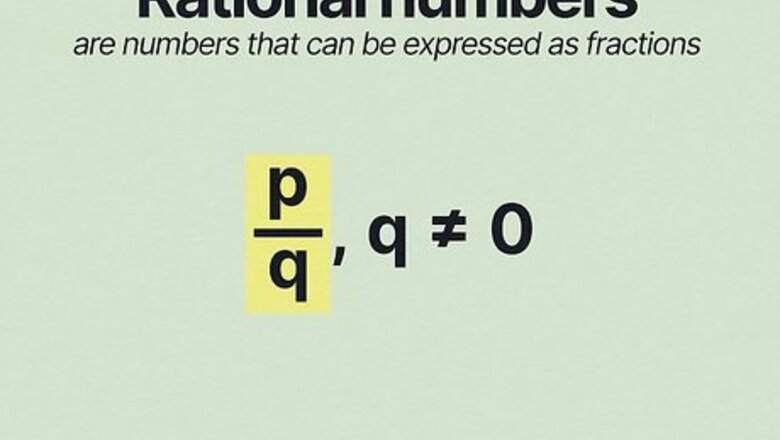
views
- Rational numbers can be expressed in the form of a p/q fraction, where the denominator, q, does not equal 0.
- Irrational numbers cannot be simplified into a fraction with whole numbers as the numerator and denominator.
- Rational numbers as decimals are either finite or have a repeating pattern, whereas irrational numbers as decimals don’t have a pattern and don’t end.
What are rational and irrational numbers?
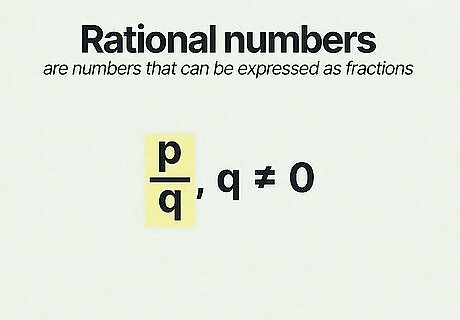
Rational numbers are numbers that can be expressed as fractions. A rational number is a type of real number in the form of a fraction, p/q, where q does not equal 0. In short, they’re ratios made from 2 integers or whole numbers. Rational numbers can also be expressed as both positive and negative numbers, and 0 itself is also a rational number. Identify a rational number by checking to see if it can be represented as p/q, where q≠0. Then, ensure you can further simplify the p/q ratio and translate it into decimal form. For example, ¾ is a rational number because it can be calculated as a fraction where q (4) does not equal 0, and its decimal form (.75) is finite.
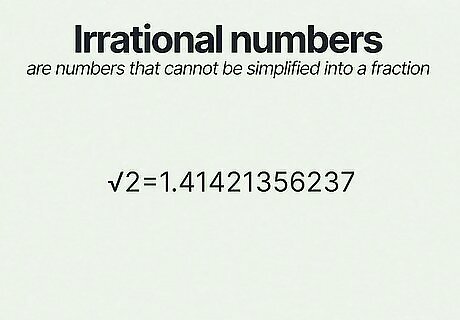
Irrational numbers can be written in decimals but not as fractions. As a contradiction of rational numbers, irrational numbers cannot be simplified into a fraction or expressed as a ratio of integers. Instead, they’re often expressed in square root (√) form or as a decimal. After the decimal point of an irrational number, there are endless non-repeating digits. Identifying an irrational number is simple! Check to see if it can be expressed as a fraction, where p and q are integers and q ≠ 0. If it can’t, then it’s an irrational number. For example, √2 (the square root of 2) is irrational. When expressed as a decimal, it becomes the number 1.41421356237…, which cannot be made into a simple fraction.
Classifying Rational Numbers
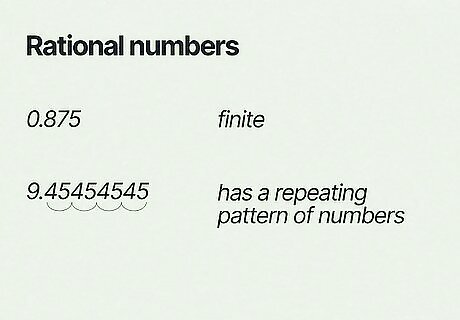
Rational numbers become finite or recurring decimals when divided. You can identify rational numbers based on their appearance in decimal form. When a decimal is finite (meaning it ends rather than continuing in an infinite string of numbers) or has a repeating pattern of numbers, it is a rational number that can be converted into a fraction. A decimal number does not need both properties to be rational; it can be either finite or recurring. An example of a finite decimal would be .875, which can be expressed as the rational number ⅞. An infinite but recurring decimal like 9.45454545… is rational. You can identify it by looking at the numbers after the decimal point; the “45” repeating pattern confirms this number as rational.
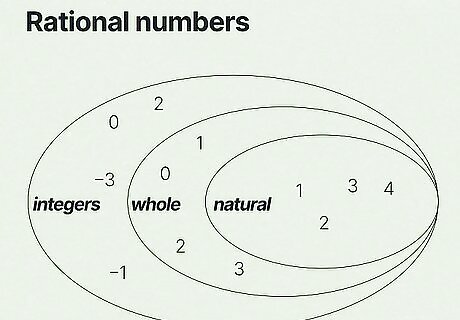
Whole numbers, natural numbers, and integers are all rational. This is a fairly wide umbrella: whole numbers are numbers that are not fractions (0, 1, 2, 3…), while integers include all of those numbers and their negative counterparts (-2, -1, 0, 1, 2…). Natural numbers are simply all positive integers (1, 2, 3, 4, 5…). These numbers are rational because they can all be expressed as a simple fraction, p/q, where q ≠ 0. For example, 2 becomes 2/1, -2 becomes -2/1, and so on. Since a rational number is defined as a ratio or fraction made from 2 integers, any integer, whole, or natural number qualifies as rational.

Perfect squares are rational because they're whole numbers. When you see a number expressed in square root form (like √2 or √49), some are rational, and some are irrational. Perfect squares—integers that can be expressed as the square of another integer—are rational, which you can find by solving for the square root of the number written. For example, √49 is a rational number. When you solve to find the square root of 49, the answer is 7 (an integer expressed as the square of 49, another integer), which can also be written as the fraction 7/1.
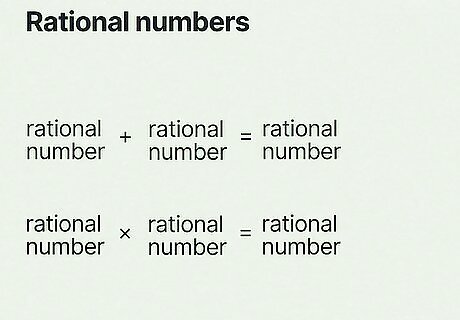
The sum or product of rational numbers is always rational. No matter which 2 rational numbers you add or multiply together, you’ll always get a rational number as your answer. For example, look at the rational numbers ½ and ⅓. If you add them together, the answer is ⅚, and if you multiply them, the answer is ⅙. ⅚ and ⅙ are both rational numbers because they are simple fractions made from whole numbers.
Classifying Irrational Numbers
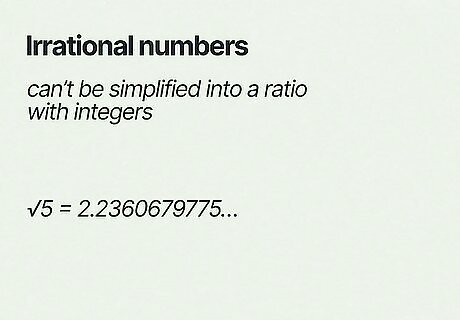
Irrational numbers can’t be simplified into a ratio with integers. When you encounter a number that is impossible to turn into a fraction made up of whole numbers, that automatically makes it an irrational number. Conversely, you can tell when a number isn’t irrational if you can successfully express it as a ratio. √5 is irrational. When you solve for the square root of 5, the result is 2.2360679775…, which can’t be converted into a simple fraction.

Non-terminating and non-recurring decimals are irrational. When looking at a number with decimals, you don’t need to do any math to identify it as either rational or irrational. Simply study the decimals! When the number is non-terminating (meaning it doesn’t end) and non-recurring (meaning there’s no repetitive pattern to the numbers), it’s definitively irrational. A number like 3.605551275… is irrational. If you look at it, you can see that it’s both non-terminating (indicated by the ellipses) and non-repeating (the numbers do not make a pattern).
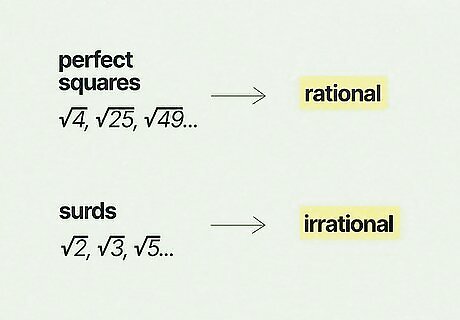
Surds are also considered irrational numbers. When calculating square roots, there are perfect squares and surds. Where perfect squares can be simplified into whole numbers, surds are those square roots that cannot and are, therefore, irrational. If the result of a square root equation is not a whole number, it’s an irrational surd. For example, √2 is a surd. When solved, √2 is 1.41421356237…, which isn’t a whole number and can’t be expressed as a fraction.
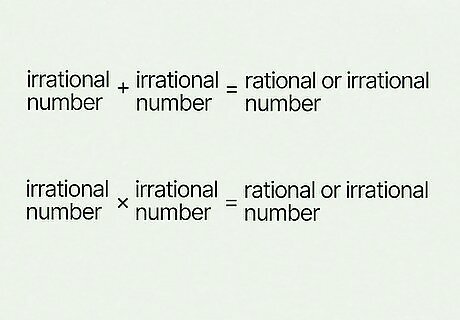
The sum or product of irrational numbers is not always irrational. Unlike rational numbers, adding and multiplying irrational numbers doesn't guarantee a particular type of result. It depends entirely on the numbers you're using. Sometimes the solution will be irrational, and sometimes it'll be rational. For example: √2 is irrational. When you multiply the square roots √2 and √3, the answer is √6, which is also irrational. When you multiply √2 and √2, the answer is √4—which is a perfect square and a rational number.
More Examples
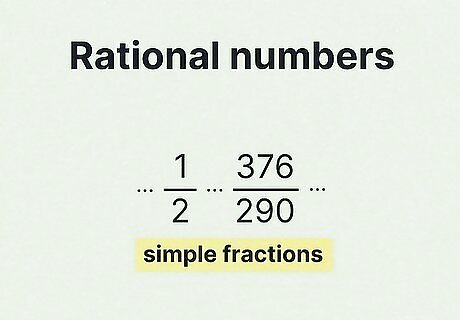
Simple fractions like ½ are rational numbers. Not only is ½ a fraction made from whole numbers where the denominator is not equal to 0, but it can also be expressed as a finite decimal (.5). All fractions from ⅓ and ⅕ to 376/290 are rational numbers. Note that the denominator of a rational number can be any real number at all, so long as it isn’t 0.
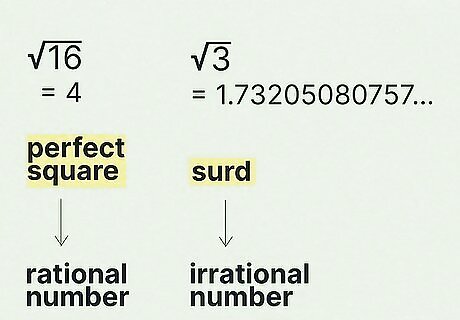
√16 is a rational number, while √3 is irrational. Comparing square roots, √16 simplifies to 4, a whole number, meaning that it’s a perfect square and a rational number. Meanwhile, √3 simplifies to 1.73205080757…, a non-terminating and non-repeating decimal, meaning that it’s a surd and an irrational number.

π is an irrational number, but .777777 is a rational number. We’ve all seen the symbol for pi (π) before, but what does the number actually look like? As a decimal, π is expressed as 3.14159265259…, a non-terminating and non-repeating number and therefore irrational. Conversely, a decimal like .777777 is rational because even though it is also non-terminating, the number 7 repeats continually.


















Comments
0 comment